Archive for the ‘52 Ancestors’ Category
52 Ancestors in 52 Weeks nos. 39-44—Unknown Ancestors
 Six of my third great-grandparents remain unidentified. Four lurk in the shadows of history, nameless and faceless. Two others, I can name only as Mr. and Mrs. Riddle, and I know nothing more about them.
Six of my third great-grandparents remain unidentified. Four lurk in the shadows of history, nameless and faceless. Two others, I can name only as Mr. and Mrs. Riddle, and I know nothing more about them.
The four unknown subjects had a grandson who fathered my grandmother. Who was he, and who were his people?
As I have written many times on these pages, my grandmother arrived in the world in Palisade, Nebraska in August, 1896. When I quizzed her about it in the 1960’s, she stated she had no knowledge of her father’s identity. Information on her parentage did not come down through collateral family lines even though many cousins knew that her mom was an unwed mother. The father’s name has been a well-guarded secret for over 100 years.
No clues have come to light in all these years. Her father did not give her his name. Did he even know she existed? Before she married, Grandma sometimes went by her mother’s maiden name, Riddle, and sometimes she used the surname of the aunt who raised her, Evert.
Grandma’s maternal Riddle family, presents only slightly less of a challenge. Her grandfather, John Davis Riddle (1821-1896), reportedly was born in Pennsylvania to the elusive Mr. and Mrs. Riddle. The first record of John was when he (as John Davis, not John Davis Riddle) married Olla Dunbar in Summit County, Ohio in 1843. The couple shortly relocated to Mendon, Michigan where they lived out their lives. No Riddle descendant ever heard or recorded any information about John’s birth family. Who were his people?
Six unknown ancestors. How will I ever identify them? DNA testing might provide some answers, and I keep hoping for a promising match. Beyond that, the riddle of the Riddles will make an interesting research project one day.
52 Ancestors in 52 Weeks nos. 37 & 38, The Stanabaughs
 I know nothing about my ancestors, Mr. and Mrs. Stanabaugh. I do not even know whether this is their real name. In fact, it probably isn’t. Why not, and where did we find it?
I know nothing about my ancestors, Mr. and Mrs. Stanabaugh. I do not even know whether this is their real name. In fact, it probably isn’t. Why not, and where did we find it?
- The name comes from that provided on my great-grandmother’s death certificate in 1961. It lists the decedent’s mother’s name as Katherine Stanabaugh. This information was provided by my great-grandmother’s second-to-youngest child, almost a hundred years after the said Katherine Stanabaugh had passed away. Talk about second-hand information!
- I have a letter from my great-grandmother’s oldest child saying that the mother’s name was Katherine Stillenbaugh. This letter was written even later, in the 1980’s, when the writer was nearly 100 years old herself.
- German researchers advise us to check the German phone book for supposedly German surnames. If they do not appear there, the name has likely been garbled along the way. Neither name, Stanabaugh nor Stillenbaugh, appears in the German phone directory. These names do not appear on U.S. census records either.
If their name was not Stanabaugh or Stillenbaugh, what was it? I have so few clues:
- My great-grandmother said her mother came from Germany as a child. My great-grandmother was born in 1865 in Indiana, home to a large German population.
- Many Germans immigrated to America after civil unrest in Germany in 1848. A child coming over at that time would have been the right age to have a child of her own in 1865.
- My great-grandfather, Thomas Sherman, had German neighbors named Stilgenbauer when he lived in Indiana in the 1860’s. This name is tantalizingly close to Stanabaugh or Stillenbaugh.
I have not yet been able to fit my Katherine into any German family, let alone a Stilgenbauer family, in Indiana between 1848 and 1865. Mr. and Mrs. Stanabaugh would be the parents in this theoretical family, but so far they remain unidentified.
This unknown family represents a huge brick wall in my ancestry. Next year I will pull out all the pertinent information I have on these people, go over it again, and tackle the suggested research again. Will 2017 be the year I can add my German ancestors to my family tree?
52 Ancestors in 52 Weeks no. 36—Rebecca Howe Day (1808-1876)
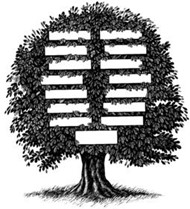 A search for the Day family in central Kentucky during the 1800’s reveals a large extended family, difficult to sort. My 3rd great-grandmother Rebecca was born into this clan on the 5th of June, 1808. She was named for her maternal grandmother, Rebecca Howe. Her parents were Daniel Day and Rhoda Hoskins. Young Rebecca actually was born in Tennessee, but the family soon moved on to Kentucky.
A search for the Day family in central Kentucky during the 1800’s reveals a large extended family, difficult to sort. My 3rd great-grandmother Rebecca was born into this clan on the 5th of June, 1808. She was named for her maternal grandmother, Rebecca Howe. Her parents were Daniel Day and Rhoda Hoskins. Young Rebecca actually was born in Tennessee, but the family soon moved on to Kentucky.
Rebecca’s father died when she was young, and she became the ward of her grandfather, John Day, a Revolutionary War veteran from Virginia. The family had settled in Morgan County when they reached Kentucky. There, Rebecca met a blacksmith, Daniel Sherman, and they decided to marry. The marriage took place on September 4, 1826 when Rebecca was eighteen years old.
Over the next years, Rebecca and Daniel traveled around central Kentucky and southern Ohio, wherever Daniel found work. Together they raised a large family of about ten children. By the time the Civil War broke out, they resided in Madison County, Kentucky.
At some point as the war progressed, they made the decision to move north. On April 29, 1863, they sold their small holding in Madison County. After that, Daniel disappears from the record. They may have relocated to Johnson County, Indiana where their eldest son, Anderson Sherman, lived.
By 1870, Rebecca, by then a widow, had moved again, following some of her children to Edgar County, Illinois. That year her household included her third son, John, and a granddaughter Anna Petronellia, the daughter of Rebecca’s second son, Thomas. Other Sherman children (Thomas Sherman, Evaline Sherman Alvey, and Jasper Sherman) lived in the same county.
Rebecca died in Edgar County on September 28, 1876. She was buried in the Swango Cemetery in Symmes Township although her grave is unmarked.
Much research remains to do on Rebecca and her birth family. Sources conflict on when and where her father died. Some family members claim her mother lived to be over 100 years old, although we have no proof of that. Some researchers claim Rebecca descended from the illustrious Howe family of Revolutionary War fame with connections to the English royal family.
Rebecca Howe Day will make a fascinating research subject when time permits.
52 Ancestors in 52 Weeks no. 35—Daniel Sherman (abt. 1800-?)
 As we work further back in time, the details on our ancestors’ lives become murkier. Eventually, we find little or no information about them.
As we work further back in time, the details on our ancestors’ lives become murkier. Eventually, we find little or no information about them.
For many years now, one of my 3rd great-grandfathers, Daniel Sherman, has been what genealogists call a “brick wall” ancestor. He seemingly appeared out of nowhere, raised a large family, and then disappeared again. I know nothing about his birth family.
According to U.S. census records for Kentucky in 1850 and 1860, Daniel originally came from New York. He was born around 1800. He worked as a blacksmith, but he also had some education. In the 1850’s he wrote out permission slips for his daughters to marry.
Daniel began appearing in the Kentucky records in the late 1820’s. He married Rebecca Howe Day on September 4, 1826 in Morgan County. The next year, his name came up a couple of times in the Morgan County court minutes. The first time, he was appointed to take his turn to keep the state road in good repair. The second time, he was ordered to pay 37 ½ cents to a member of his wife’s family in a case involving horse feed. In 1828, he received payment of $2 when he resigned as county jailor.
That same year, Daniel and Rebecca started their family. They had at least ten children:
- Polly Ann, born about 1828
- Unknown daughter, born about 1829
- Anderson O., born 22 Aug. 1832
- Evaline, born 5 Aug. 1834
- Emily Elizabeth, born about 1836
- Eliza/Louisa Jane, born about 1838
- Thomas, my 2nd great-grandfather, born 23 Nov. 1841
- Gilla Ann, born 26 Mar. 1843
- John, born Dec. 1845
- Jasper, born 30 Oct 1849
During these years, Daniel and his wife moved around a lot. Their children were born in various Kentucky counties (Morgan, Bath, Clark, Madison, Estill) as well as in Scioto County, Ohio. The couple never seemed to own much land. Apparently, they followed the work he could get.
By 1853, Daniel finally appeared more ready to settle down in one place. On September 25 that year, he gave permission for his teenage daughter Eliza/Louisa to marry in Madison County. Several years later, on 4 January 1858, he purchased an acre of land on Clear Creek in the same county. Perhaps they intended to remain there with grown children nearby.
Then, during the course of the Civil War, for some reason Daniel and Rebecca changed their minds and decided to leave Madison County. They sold their land on 29 April 1863.
After that, Daniel disappears from the records. By 1870, Rebecca lived with relatives in Edgar County, Illinois. Daniel’s name has not been found on the 1870 census, so he probably died before then.
Before he died, Daniel passed some of his learning on to his sons. All of them picked up the blacksmith trade. That is how the family continued to earn its living into the next generation, well into the twentieth century.
So, who were Daniel’s people? When did his Sherman family come to America? Where did he end his days? The answers to these questions about the life of Daniel Sherman await discovery.
52 Ancestors in 52 Weeks no. 34—Mary (Polly) Templeton (1792-1857)
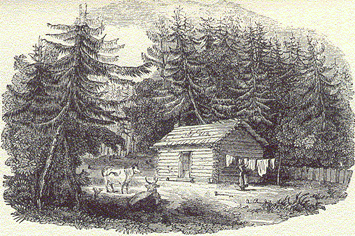 My family does not have much information (yet!) about our ancestor Polly Templeton Carter. For all I know, data on her may be just a few steps away in my office. A couple of years ago I inherited the genealogical work of my dad’s cousin, and perhaps she documented some of Polly’s life. If so, the information still sits in notebooks and file drawers I have not yet had a chance to review.
My family does not have much information (yet!) about our ancestor Polly Templeton Carter. For all I know, data on her may be just a few steps away in my office. A couple of years ago I inherited the genealogical work of my dad’s cousin, and perhaps she documented some of Polly’s life. If so, the information still sits in notebooks and file drawers I have not yet had a chance to review.
For my own part, I have not done any work on the Templeton family.
Mary Templeton, known to us as Polly, was born in 1792 in eastern Tennessee. I do not know the identity of her parents.
Polly grew up in Tennessee, and there she married John Carter on the ninth of February, 1815. After their first child, Susan, was born later that year, they moved on to Wayne County, Kentucky. Between 1816 and 1829, they had seven more children, including my second great-grandmother, Jane.
We do not know how Polly and John learned that new lands had come available for settlement in southeastern Illinois. We do not know why they decided to uproot their large family and make the move. We just know that they became “Pioneers of 1830” who settled near Ashmore, Coles County, Illinois.
Their last child, Catharine, was born there in 1832.
The family settled into pioneer life, and all went along well until John became ill. He passed away in 1841, and Polly was widowed at age 49. She never remarried.
She seemed to have moved around some after that. In 1855, she lived alone in Edgar County (next to Coles County), and she kept $180 worth of livestock.
Over the next couple of years, she performed acts that left the only records we have of her life. She presented an inscribed Bible to her daughter Jane in 1856. In 1857, she executed a Bounty Land Claim for her husband’s long-ago service in the War of 1812.
Polly passed away on 11 November 1857 in Coles County at the age of sixty-four. She was buried next to John in the Ashmore, Illinois cemetery.
Polly died intestate, but she did leave an estate that needed to be administered. Her son Joseph was named Administrator in 1858. Her monies were distributed to her heirs with $39.57 going to each:
- Susan Austin (daughter)
- Catharine Young (daughter)
- Solomon Collins (son of deceased daughter Thena)
- Nancy Boyd (daughter)
- Shelton Carter (son)
- Jane Reed (daughter)
- Joseph Carter (son)
- John Carter, minor (son of deceased son Bailey)
52 Ancestors in 52 Weeks no. 33—John Carter (ca. 1790-1841)
 John Carter, my 3rd great-grandfather, came from a prolific Carter clan. We do not really know the identities of his parents, but his father may have been named Caleb Carter.
John Carter, my 3rd great-grandfather, came from a prolific Carter clan. We do not really know the identities of his parents, but his father may have been named Caleb Carter.
John hailed from Greene County, Tennessee, one of numerous Carters in the county. Various sources report his birth date as 19 July in 1783, 1784, 1790, or 1793. His daughter Jane’s family Bible provides the 1790 date.
According to his widow’s claim for bounty land, John was drafted for the War of 1812 in February 1813 for the term of three months. He continued in actual service for six months. Her claim states he served as a private in the company of Captain Hyle under the command of Colonel Gibbs. At the time, his residence was Greenville, Tennessee.
After the war, John wanted to marry a neighbor girl, Polly Templeton. On 9 February, 1815 in Greene County, he executed an affidavit saying in part: on the 7 day of this instant he obtained a lacence (sic) of clerk of sd county to marry him the said Carter to Polly Templeton and further states that he lost them.” John signed the document with a mark, indicating that he could not write.
John did marry Polly that same day at Greenville, Tennessee. The first of their nine children arrived later that year:
- Susan (1815-1884)
- Shelton (1816-1890)
- Nancy (1818-1901)
- Bailey (abt. 1820-1847)
- Thena (1823-1855)
- Janete or Jane (1824-1907)
- Joseph (1827-1903)
- Elizabeth (1829-1848)
- Catharine (1832-1885)
After Susan’s birth, the family moved on to Wayne County, Kentucky. They lived in that state a number of years. When some lands opened up for settlement in Illinois, the Carters pulled up stakes and moved again. They became “Pioneers of 1830” in the about-to-be-formed Coles County, arriving on April 10 of that year. They settled east of the village of Ashmore.
Initially, John worked sometimes as a blacksmith in addition to farming. When other blacksmiths moved into the area, he gave up that trade and focused on his farm.
By 1841, John had become ill and knew he was dying. He asked that his funeral service be conducted on the Sabbath after his death. He requested the Scripture from the second Epistle of Paul to Timothy: 6-8. He said, “For I am now ready to be offered, and the time of my departure is at hand. I have fought a good fight. I have finished my course. I have kept the Faith. Henceforth there is laid up for me a crown of righteousness which the Lord, the righteous judge, shall give me at that day, and not to me only but unto all those also that love his appearing.” He instructed his children to “do the best you can and try and meet me in heaven.”
John passed away on July 19, 1841. He was buried in the Ashmore Cemetery, Coles County, Illinois.
52 Ancestors in 52 Weeks, no. 32—Ann Kirkham (1782?-1869)
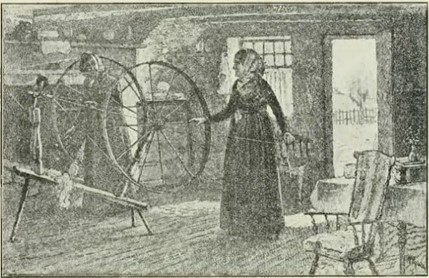 Ann Kirkham, my 3rd great-grandmother, pursued the hard life of a pioneer but lived to a ripe, old age nevertheless. She must have been made of tough stuff.
Ann Kirkham, my 3rd great-grandmother, pursued the hard life of a pioneer but lived to a ripe, old age nevertheless. She must have been made of tough stuff.
Her actual birth place, date, and year have not been proven as far as I know. Records agree that she was born during the month of August, but the date varies as 1782 or 1783. Some sources say she was born in Kentucky; others report her birthplace as Pennsylvania.
By 1806 she lived in Nelson County, Kentucky when she married Thomas Reed. They wed on November 24 and then relocated to live near Thomas’ family in Spencer County. There the couple had five children: Robertson Mitchell (1808), Eliza (1810), Jane (1817), Caleb (1818), and William (1822). Given the long spaces between Eliza and Jane, and again between Caleb and William, perhaps there were other children who died young.
In 1829, Thomas Reed sold his Kentucky holdings. He and other family members struck out for newly opened lands in Indiana and Illinois. Thomas and Ann chose the latter, settling in Coles County, Illinois after the new year in 1830. They took along as much of their household goods as they could, including Ann’s spinning wheel.
Early Coles County families faced a primitive life. They built cabins of unhewn logs with puncheon floors. Chimneys were made of sticks and clay. Perhaps Ann could enjoy some time quilting or sewing with nearby women-folk while Thomas and the other men constructed the first homes.
The couple built a financially successful life in Illinois, but personal tragedy struck periodically. Ann made the trip to the fresh graves of family members many times over the years:
- In 1836, her son-in-law John Mitchell McAlister (Eliza’s husband), died,
- In 1845 her son William passed away,
- In 1852 her husband Thomas died, leaving her a widow,
- In 1853 her daughter-in-law Nancy McAlister Reed, who was Robertson’s wife, died,
- In 1854, her grandson and Caleb’s third son, Thomas B. Reed, died in infancy,
- In 1855, her granddaughter and Caleb’s oldest daughter, Mary C. Reed, died at the age of eight,
- In 1856, her granddaughter Susan McAlister Galbreath (Eliza’s daughter) died from complications of childbirth,
- In 1864, another grandson, Caleb’s son James N. Reed, died in infancy.
During her latter years, after Thomas’ death, Ann made her home with her son Caleb and his family. When she reached her mid-80’s her life was drawing to a close. Ann passed away on 3 February 1869. She was buried beside Thomas in the Reed-McAlister Cemetery in Coles County, Illinois.
52 Ancestors in 52 Weeks, no. 31—Thomas Reed (1783-1852)
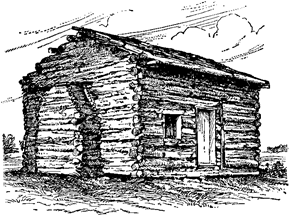 Thomas Reed was my paternal 3rd great-grandfather. He was born in one place, raised in another, and lived his adult life in yet a third locality.
Thomas Reed was my paternal 3rd great-grandfather. He was born in one place, raised in another, and lived his adult life in yet a third locality.
According to family records, Thomas arrived perhaps on the 18th of December, 1783 in Fayette County, Pennsylvania. His father was Caleb Reed, and his mother may have been Rebecca Carr. Thomas’ actual birthdate remains uncertain because his cemetery marker in the Reed family cemetery provides the calculation for a different date. It states that he died on 21 December 1852 at the age of 70 years, 11 months, and 23 days. This information means he would have been born 29 Jan 1781. So far I have no explanation for the difference in proposed birth years, nor do I know which, 1783 or 1781, is more likely correct.
In either case, Thomas came into the world during the close of the Revolutionary War era. The family lived on the fluid border between Pennsylvania and then-Virginia, now West Virginia. His uncle Joshua Reed served in the Virginia militia during that conflict. As with all American families at the time, the Reeds were affected by the war.
At some point, the Reeds relocated to Kentucky, near Louisville. Thomas married Ann Kirkham in Nelson County, Kentucky on 24 November 1806. The couple settled onto a place in Spencer County and had a family of five children:
- Robertson Mitchell Reed (1808-1871)
- Eliza Reed (1810-1886)
- Jane Reed (1817-1899)
- Joseph Caleb Reed (1818-1903), my great-great grandfather
- William Reed (1822-1845)
In 1829, Thomas and Ann made the decision to move on to new lands opening up for settlement in Illinois. They left Kentucky on December 1, their son Caleb’s 11th birthday, and headed for southeastern Illinois, near the Indiana border. With a 6-horse team, the journey took nearly a month. They stopped in Edgar County, Illinois for a few days, and they liked the Grandview area very much. However, the “milk sickness” malady was rumored to be common there, so they went further west into Coles County. They settled about a mile and a half northeast of the village of Ashmore where Thomas entered a tract of land. Among his Coles County neighbors was Thomas Lincoln, father of the future President.
Once settled in, Thomas Reed went walking one day with his neighbor, Daniel McAlister. They stopped at a particularly beautiful spot and decided it would make a lovely place for a burial ground. They set it aside as the Reed-McAlister Cemetery. Both would be buried there someday.
In 1832, Thomas’ father Caleb, who had also left Kentucky and moved on to Indiana, passed away. Thomas received his timepiece.
Thomas and Ann worked to build up their farm and raise their family in Illinois. Thomas was known as a quiet and industrious man, and at one time he farmed nearly a thousand acres. It was about half prairie and half woodland with streams of water flowing through most of it.
Politically, Thomas was a strong Whig, but he never sought public office. Farming took all his time.
Thomas passed away on 21 Dec 1852 and was buried in the family cemetery in Coles, County, Illinois. He died intestate, and his farm was divided into four parts. Each surviving child received a share, but the daughters sold theirs to the sons, with Robertson, the eldest, receiving a larger share. Thomas’ daughter Eliza’s husband James Walton served as Personal Representative.
Thomas Reed became the patriarch of a large Reed clan in Coles County, Illinois. Descendants live and farm there to the present day. Thomas chose a good place to settle down.
52 Ancestors in 52 Weeks, nos. 29 & 30—Matti Lampinen (b. 1835) and Anna Miettinen (b.1832)
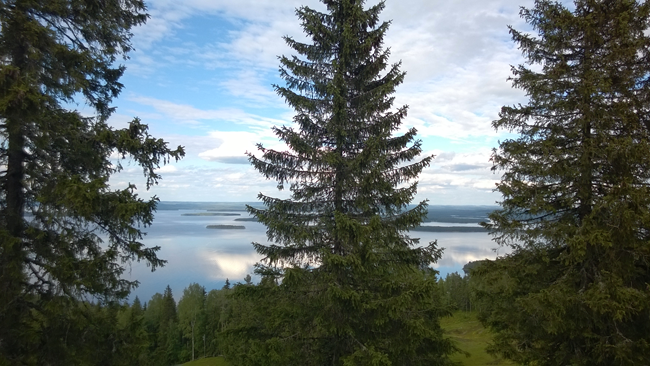
Karelia
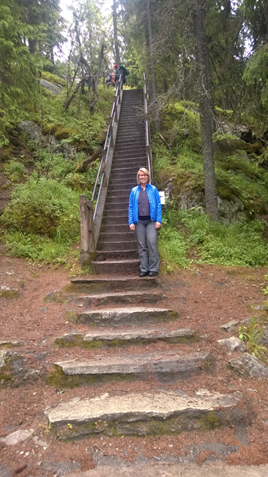 The Lampinen family lived in the area of the present-day Koli National Park in eastern Finland. The park lies west of Lake Pielinen, the fourth-largest in Finland, in the sub-region known as Karelia. Here the gorgeous forest landscape near the lake includes rock outcroppings intermingled with lush groves of spruce, birch, and other trees. The undergrowth is rich in mushrooms and berries. Wolverine, lynx, bear, and beaver abound.
The Lampinen family lived in the area of the present-day Koli National Park in eastern Finland. The park lies west of Lake Pielinen, the fourth-largest in Finland, in the sub-region known as Karelia. Here the gorgeous forest landscape near the lake includes rock outcroppings intermingled with lush groves of spruce, birch, and other trees. The undergrowth is rich in mushrooms and berries. Wolverine, lynx, bear, and beaver abound.
People have lived in the Koli area since before Christianity. It had been a center of pre-Christian religion. The highest point above the lake is still known as the Temple of Silence. The cave formations in the nearby rocks were thought to house wizards and witches.
The Karelians consider themselves the true Finns, uncorrupted by Swedish intermarriage and Germanic influence. Unlike many other Finns, they are lively and talkative. Historically, they ate a distinctive diet marked with local fish and game, often made into pasties.
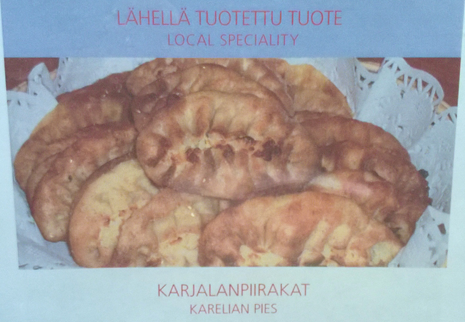
Karelia, especially the Koli area, became a vacation destination for hikers and skiers in the 19th century. Others, including Finland’s great composer Jean Sibelius, came to enjoy the local folklore and the traditional culture. By the time these visitors discovered Koli, the Lampinen family had lived there for a long time.
In the 1830’s they ived in the tiny Karelian village of Nunnanlaks on the western shore of Lake Pielinen. There Valborg Johansdotter Ruottin (1808-after 1860) gave birth to her son Matti Lampinen on 27 September 1835.
She and her husband Henric Mårtensson Lambin (1806-1837) had him baptized in the Juuka parish on 25 October 1835. At this time, spelling and naming patterns had not become standardized, so we see the family name in the records in several iterations, including Lambin, Lampin, Lambinen, and Lampinen. Karelians were early adopters of surnames because they moved around a lot.
Little Matti joined an older brother, Henric, who had been born on 8 August 1832 in the same village. They probably lived in a log house decorated with carvings, but those houses no longer remain. Today Nunnanlaks is known for its soapstone mine.
The boys were born into an ancient swidden, or slash-and-burn culture. Crofters like their father lived by cultivating clearings in the forest. They felled and burned broad-leaf trees, especially birch, in 10-to-30-year intervals. This created a patchwork landscape of varied woodland habitat around settlements.
In the second year, crofters planted turnips, sowed by spitting the seeds. They stored these and other root crops like carrots and rutabaga in cellars dug in the ground.
The third year, they could plant grains such as oats, flax, buckwheat, and rye. They built traditional pole fences to protect these crop fields from livestock. In the fall, they harvested the crops by hand, with a sickle, and then threshed them in a barn.
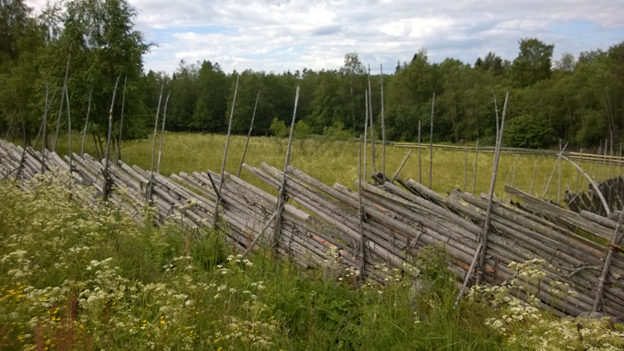 A traditional Finnish fence
A traditional Finnish fence
Once the soil became depleted, they began the swidden cycle again in a new location. As young trees began to grow back, they grazed livestock in the sparse, well-lit forest. They often acquired a pig around midsummer to fatten up for Christmas.
The little Lampinen family did not stay long at Nunnanlaks. By early 1837, when Matti was just over a year old, they had moved on to an inland village, Kuhnusta. That year, the elder Henric contracted typhoid fever and died on 10 February 1837 at the age of thirty. It is unlikely that Matti would have had any memories of his father.
His mother remarried the next year. Valborg Ruottin and Christer Mårtensson Karjalain were wed in Juuka parish on 1 September 1838. Their son Eric, Matti’s half-brother, was born on 29 April 1839 at Nunnanlaks. He was followed by a half-sister named Christina on 24 September 1841.
By 1842, this family, too, had located in Kuhnusta. There, tragedy struck again, and on 2 June 1842 Christer Karjalain died at age 31 from a heart attack. Seven-year-old Matti was fatherless for the second time.
It seems Valborg waited several years to marry a third time. When Matti and Henric were 14 and 17, their mother and Anders Rompanen married. Again in the Juuka parish, the wedding occurred on 14 April 1850. During the following decade, Valborg and Anders lived sometimes at Kuhnusta and sometimes at Nunnanlaks.
Also during the 1850’s Matti courted a young woman from the neighboring village of Halivaara. Anna Miettinen was three years older than Matti. Her parents were Henric Henricson Miettinen (c.1804-1836) of Halivaara and Anna Andersdotter Toivain (1802-after1858) of Kajo.
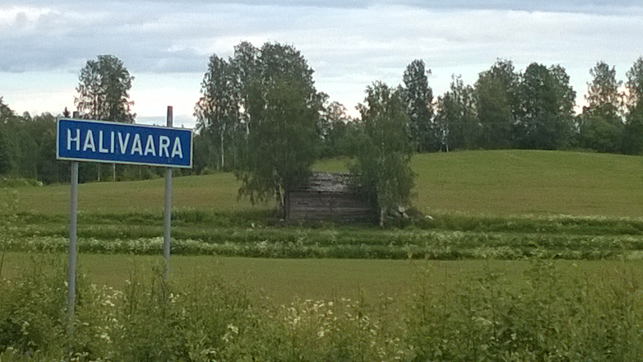
Anna Miettinen’s parents had married in Juuka parish on 27 December 1819, and they had seven children, all born at Halivaara:
- Carin, born 30 June 1821,
- Henric, born 3 August 1823,
- Christina, born 9 November 1827,
- Margret, born 17 September 1829,
- Johan, born 17 February 1830,
- Anna, born 5 February 1832,
- Brita, born 7 August 1835.
Like Matti, Anna lost her father at an early age. Henric Miettinen died of a fever at age 32 at Halivaara on 22 October 1836, when Anna was four years old. No more is known of Anna’s mother Anna Toivain. She was still living at age 55 when she attended a kinkeri or catechism meeting in Juuka parish in 1857.
Matti Lampinen and Anna Miettinen were married in Juuka parish on 7 December 1856. As his father had, Matti worked as a cottager, or tenant farmer.
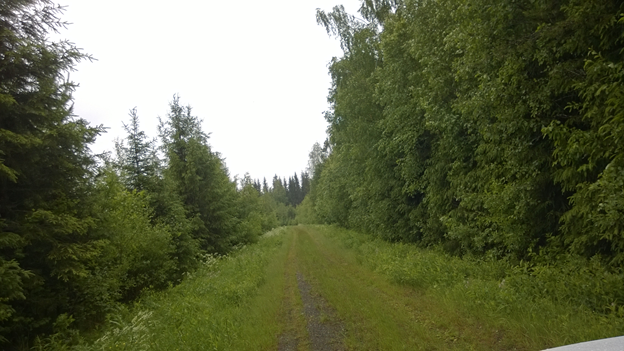 Forest near Nunnanlaks and Kuhnusta
Forest near Nunnanlaks and Kuhnusta
They lived sometimes at Nunnanlaks and sometimes at Kuhnusta, and they had the typically large Finnish family of twelve children:
- Henric, born at Nunnanlaks on 14 July 1857,
- Anna Valborg, born at Kuhnusta on 2 May 1859,
- Eva Stina, born at Kuhnusta on 26 March 1861,
- Hendrika, born at Nunnanlaks on 27 November 1862,
- Matts, born at Nunnanlaks on 9 May 1864,
- Alexander, born at Nunnanlaks on 1 April 1866,
- Adam, born at Nunnanlaks on 1 April 1868,
- Alexis, born at Nunnanlaks on 2 August 1868,
- Mathias, born at Nunnanlaks on 7 December 1870,
- Lovisa, born at Nunnanlaks on 11 March 1873,
- Anders, born at Nunnanlaks on 6 December 1876,
- Ada Alina, born at Nunnanlaks on 25 September 1879.
We do not know how long Matti and Anna lived because the available records end in 1880, the year after Ada Alina was born. Presumably, they lived out their lives in Juuka parish and were buried there.
 Juuka church
Juuka church
During their lifetime, the Koli area began to attract big names in Finnish art. Painters like Eero Järnefelt and composers like Jean Sibelius returned year after year for inspiration. Järnefelt painted the internationally-known An Autumn Scene on Lake Pielisjärvi in 1899, and Sibelius composed his fourth symphony (“Koli”) in 1909 after a trip there. The Koli National Park was eventually founded in 1991. Today, the entire area where Matti and Anna Lampinen lived is a beautiful park enjoyed by all the Finns.
52 Ancestors in 52 Weeks nos. 25 & 26—Antti Abelsson Mattila (1826-1882) and Elisabeth Myllynen (1836-a. 1908)
Born on 4 November 1826, Antti Mattila lived during the years when Finland retained a strong legacy of the Swedish language in both spoken use and record-keeping. Hence, in the records we sometimes find him called by his Finnish name, Antti, and sometimes by his Swedish name, Anders. The English version of this name is Andrew.
He must have been named for his grandfather because his father’s name was Abel Andersson (c. 1798-1852). The Andersson patronymic means son of Anders. Abel was Anders’ son, so Antti (Anders) was Anders’ grandson. Antti’s mother was Greta Caspersdotter (c. 1798-?). Families at the time had no surnames, and women kept their own names after marriage. During Antti’s life, however, the idea of surnames began to catch on, and his father increasingly became known as Abel Andersson Mattila.
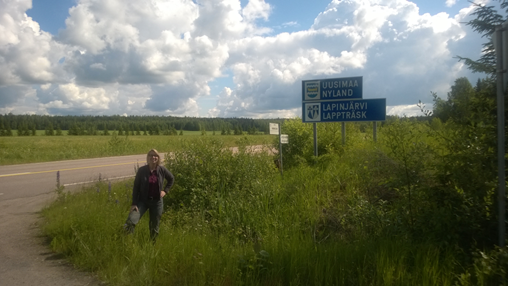 The family lived in the south of Finland, in the Uusimaa province where Helsinki is the capital.
The family lived in the south of Finland, in the Uusimaa province where Helsinki is the capital.
Antti was baptized in the Lapinjärvi parish northeast of Helsinki when he was three days old, on 7 November 1826. He had an older sister Eva (b. 1824) and at least three younger siblings: Abel (b.1829), Anna (b. 1832), and Johannes (b. 1842).
At the time of his birth, Antti’s family lived on the Kimoböle farm. The family remained in the Lapinjärvi parish, and Antti’s father died there in 1852 from a heart attack at age fifty-four. Until modern times, heart disease has been a leading cause of early death in Finland.
Although he was the oldest son, Antti left the family home. At some point he made his way east to the area of Viipuri, Finland’s second-largest city at the time. Perhaps he was lured there by the prospect of work on the Saimaa Canal being built between Lake Saimaa and Viipuri in the 1850’s.
On the Saimaa Canal boat:
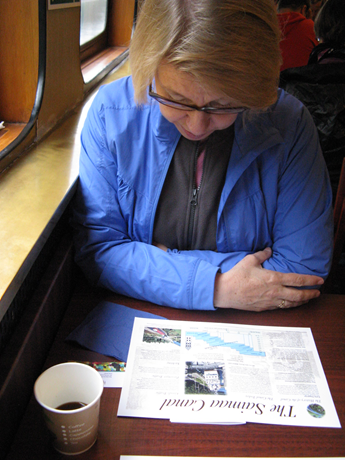
Eventually, he met a young woman, Elisabeth Myllynen, whom he married on 16 August 1863 in the Viipuri rural parish. She was the daughter of Simon Mattson Myllynen (1810-1857) and Sofia Henriksdotter Ampuja (c. 1812-?). Elisabeth, or Liisa, was a native of the area having been born on the Tervajärvi farm on 25 April 1836 and baptized in the rural parish on 8 May 1836.
Elisabeth was part of a large family of approximately seven boys and three girls. Elisabeth was several years older than her sisters Helena (b. 1841) and Regina (b.1844). The number of brothers in the family is unclear from the existing records, but they seem to include the following:
- Matthias (b. 1834)
- Henric (b. 1838) probably died young
- Henric (b. 1841)
- Philip (b. 1847) probably died young
- Adam (b. 1849) probably died young
- Filip (b. 1851)
- Adam (b. 1851)
The second Filip and Adam, although born the same year, were not twins. The family seemed to re-use well-liked names if a child died. This was common practice.
Antti and Elisabeth did not settle near her family on the Tervajärvi farm. Instead they went southwest of Viipuri and settled in a coastal village. Not far from the city, they may have been able to see the ancient castle built there by the Swedes in the 1200’s.
Husband/Tech Advisor with Viipuri castle in the background:
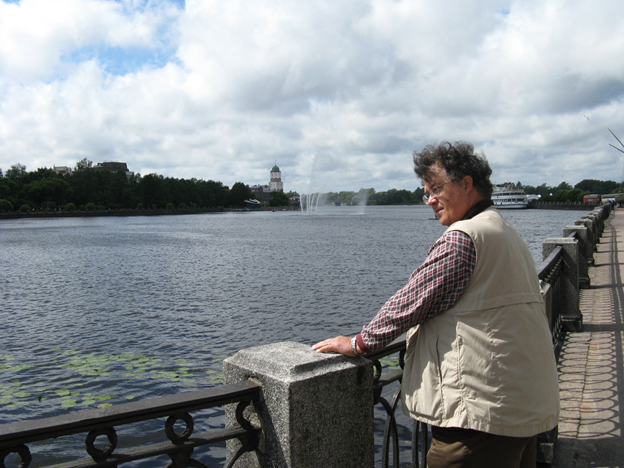
Antii worked as a steward, and they began their family. They had eight daughters and a son:
- Karolina, born 10 September 1863 at Horttana and baptized 20 September 1863. She was confirmed in 1878 in the Viipuri rural parish, but nothing more is known of her. She may have been one of the sisters purported to have married a Russian soldier.
- Eva Emilia, born 7 November 1864 at Hortanna and baptized 13 November 1864. She, too, was confirmed in the Viipuri rural parish in 1879 and may also have married a Russian soldier.
- Helena, born 20 May 1868 at Korpela Autio and baptized 28 May 1868 in the rural parish. She died from tuberculosis in 1884 at age 15 in Hortanna.
- Anna, born 23 May 1866 at Hortanna and baptized 1 June 1866 in the rural parish. Shortly after her father’s death, Anna moved out of the Viipuri area at the age of 17 and relocated to the coastal city of Kotka. A couple of years later she married Charles Anderson. They emigrated to the United States and first settled in Eveleth, Minnesota. When Anna and Charles had no children of their own, they adopted Charles and Helen Mais in the early 1900’s. Charles Anderson died between 1910 and 1920, but Anna lived another 30 years. She migrated to Hibbing, Minnesota where she was a member of the Finnish Temperance Society. She must have taken this seriously because her great-niece Joyce Bentsen Reed recalled that Mrs. Anderson strongly disapproved of liquor. She even left her niece Aida Mattila’s wedding reception in a fit of pique when she learned that her brother Alex was serving alcohol. Anna died in Hibbing on 28 April 1947 at the age of 80.
- Sofia, born 7 April 1870 at Korpela Autio and baptized in the rural parish on 1 May 1870. There she married Kalle Ville Ripatti on 15 November 1896. They had three children, Rosa Wilhelmina, Olga Alina, and Juhana Aleksander between 1896 and 1898. A few months after Juhana’s birth, Sofia’s 23-year-old husband Kalle drowned at Kolikkoinmaki (an eastern suburb of Viipuri) on 12 October 1899. Sofia’s life as a young widow after this tragic event is unknown. Her daughter Rosa eventually emigrated to America about 1913, and she too settled in the Hibbing area. She married Waino Porras and they had one son, Arthur, in 1919. Rosa died of pneumonia in 1941 at the age of 44 in Hibbing. According to family lore, she had been found nearly frozen in a snow bank before her death.
- Ida Marie, born 15 July 1872 at Korpela Autio and baptized in the rural parish on 29 July 1872. She married Juhana Mattsson there on 9 November 1890. For the next ten years they lived near Viipuri and had five children. After that, Juhana disappears from the record and Ida relocated to Kotka. In 1908, her brother-in-law Charles Anderson returned to Finland to accompany her and her surviving children to the United States. They traveled under the Mattson surname on the S.S. Republic and landed in Boston. Her travel documents describe her as 5’3″ tall with blond hair and blue eyes. Upon their arrival, Ida purportedly married a man named Sam Parks, and they settled on Minnesota’s Iron Range in Biwabik in about 1909. Together, she and he had one child, and her other children assumed the Parks surname. Sam Parks disappears from the record after the birth of their daughter. Ida’s life was cut short by stomach cancer a few years later in 1917. She died in Biwabik at the age of forty-five. Her children included:
- Elsa (1892-b. 1978) born in Finland; married Edward Glass and remained in Minnesota,
- Alice (about 1893-b. 1978) born in Finland; married William Goldsworthy and settled in Wayne County, Michigan,
- Aleksander—born in Finland, and died at two months of age in 1894,
- Yrgo (George) (about 1896-b. 1978) born in Finland,
- Martha (1900-2000) born in Finland; married (1) Joseph Hendrickson, (2) Ray Hyzer and lived in Berkeley, California,
- Bertha Ethel (1910-1986) married Eliot Haberlitz; settled in Santa Barbara, CA.
- Olga, born 20 January 1874 at Horttana and baptized in the rural parish on 1 February 1874. Olga continued to live in the Viipuri area until she was twenty-seven years old. In 1901 she moved to Kotka. Her older sister Anna Anderson returned to Finland that same year to accompany her to the United States. Three years later in 1904, Olga married Oskar Silberg in Duluth, Minnesota. They settled in Superior, Wisconsin and had one son named Alex (1906-1989). Oskar died of gangrene incurred from a shipyard accident in 1935. Olga lived almost 35 years in widowhood until she died of pneumonia at the age of ninety-five in 1969.
- Auna Elisabeth, born 23 January 1876 at Alasommes and baptized in the rural parish on 5 June 1876. Auna lived a short life of just two years, dying of croup on 22 June 1878.
-
Alexander, the only son, born about the ninth of May, probably 1878. The records conflict as to the exact date, but his baptism was recorded in the Viipuri rural parish on the 12th of May, 1878.
After the births of eight daughters, we can only imagine how Antti Mattila and Elisabeth Myllynen felt upon the safe arrival of their only son Alex. Unfortunately, Antti did not have long to live to enjoy his little boy. He died at age 55 when Alex was just four years old.
According to family lore, Antti drowned at sea. The church records, however, do not confirm this story. They state that he died of tuberculosis on 27 April 1882. He was buried in the Viipuri rural parish a few days later, on 2 May 1882. He was not the only one in the family with this terrible disease; his daughter Helena would die from it a couple of years later.
So why the story of a drowning? Perhaps American family members confused this death with the drowning of Sofia’s husband Kalle Ripatti. Both traumatic events occurred long ago in faraway Finland, and it would be easy to mix up the details.
After Antti’s death, Elisabeth cared for her younger children and made her living laying out the dead. Alex often accompanied her.
She probably lived a long life. Twentieth century Finnish records are closed, so we cannot locate a death date for her. We do know she was living at least as late as 1908 when she would have been seventy-two. That year her daughter Ida listed her as next-of-kin when she sailed for America.